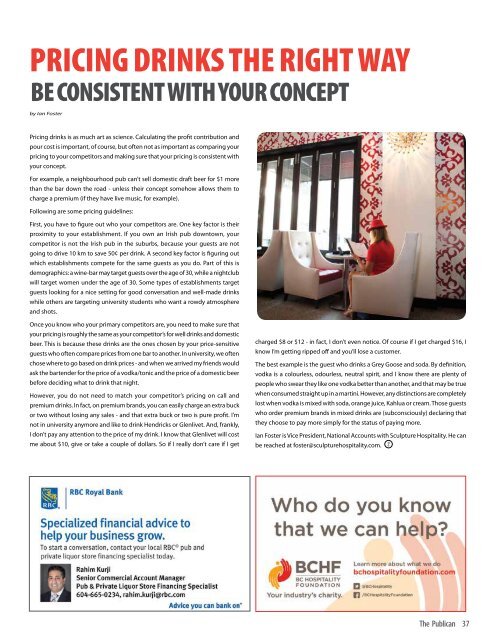Publican
pubspr16
pubspr16
You also want an ePaper? Increase the reach of your titles
YUMPU automatically turns print PDFs into web optimized ePapers that Google loves.
PRICING DRINKS THE RIGHT WAY<br />
BE CONSISTENT WITH YOUR CONCEPT<br />
by Ian Foster<br />
Pricing drinks is as much art as science. Calculating the profit contribution and<br />
pour cost is important, of course, but often not as important as comparing your<br />
pricing to your competitors and making sure that your pricing is consistent with<br />
your concept.<br />
For example, a neighbourhood pub can’t sell domestic draft beer for $1 more<br />
than the bar down the road - unless their concept somehow allows them to<br />
charge a premium (if they have live music, for example).<br />
Following are some pricing guidelines:<br />
First, you have to figure out who your competitors are. One key factor is their<br />
proximity to your establishment. If you own an Irish pub downtown, your<br />
competitor is not the Irish pub in the suburbs, because your guests are not<br />
going to drive 10 km to save 50¢ per drink. A second key factor is figuring out<br />
which establishments compete for the same guests as you do. Part of this is<br />
demographics: a wine-bar may target guests over the age of 30, while a nightclub<br />
will target women under the age of 30. Some types of establishments target<br />
guests looking for a nice setting for good conversation and well-made drinks<br />
while others are targeting university students who want a rowdy atmosphere<br />
and shots.<br />
Once you know who your primary competitors are, you need to make sure that<br />
your pricing is roughly the same as your competitor’s for well drinks and domestic<br />
beer. This is because these drinks are the ones chosen by your price-sensitive<br />
guests who often compare prices from one bar to another. In university, we often<br />
chose where to go based on drink prices - and when we arrived my friends would<br />
ask the bartender for the price of a vodka/tonic and the price of a domestic beer<br />
before deciding what to drink that night.<br />
However, you do not need to match your competitor’s pricing on call and<br />
premium drinks. In fact, on premium brands, you can easily charge an extra buck<br />
or two without losing any sales - and that extra buck or two is pure profit. I’m<br />
not in university anymore and like to drink Hendricks or Glenlivet. And, frankly,<br />
I don’t pay any attention to the price of my drink. I know that Glenlivet will cost<br />
me about $10, give or take a couple of dollars. So if I really don’t care if I get<br />
charged $8 or $12 - in fact, I don’t even notice. Of course if I get charged $16, I<br />
know I’m getting ripped off and you’ll lose a customer.<br />
The best example is the guest who drinks a Grey Goose and soda. By definition,<br />
vodka is a colourless, odourless, neutral spirit, and I know there are plenty of<br />
people who swear they like one vodka better than another, and that may be true<br />
when consumed straight up in a martini. However, any distinctions are completely<br />
lost when vodka is mixed with soda, orange juice, Kahlua or cream. Those guests<br />
who order premium brands in mixed drinks are (subconsciously) declaring that<br />
they choose to pay more simply for the status of paying more.<br />
Ian Foster is Vice President, National Accounts with Sculpture Hospitality. He can<br />
be reached at foster@sculpturehospitality.com.<br />
The <strong>Publican</strong><br />
37


